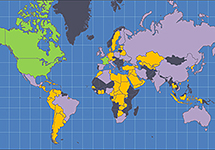Jessica Varnum
March 19, 2014
 A new nuclear trafficking report by the James Martin Center for Nonproliferation Studies (CNS) documents 153 reported incidents in 2013 involving nuclear or other radioactive material that was lost, stolen, or otherwise out of regulatory control.
A new nuclear trafficking report by the James Martin Center for Nonproliferation Studies (CNS) documents 153 reported incidents in 2013 involving nuclear or other radioactive material that was lost, stolen, or otherwise out of regulatory control.
The report is based on the CNS Global Incidents and Trafficking Database, the first globally comprehensive, free, and publicly available resource of its kind. Prepared with the support of the Nuclear Threat Initiative, the database and accompanying report are designed to help policy makers assess the nature and scope of nuclear security risks.
“Maintaining control over nuclear and other radioactive material globally is vital to both nonproliferation and the prevention of nuclear terrorism,” said CNS’s Jessica Varnum, who led the project. “As world leaders prepare to convene at the Nuclear Security Summit in The Hague next week, CNS is releasing this new resource to help inform and encourage global efforts to strengthen nuclear security.”
The CNS report highlights six key findings and associated policy implications to help decision makers understand, mitigate, and prevent future incidents.
Among the key findings:
- The overwhelming majority of reported incidents (92 percent) involved non-nuclear radioactive materials used in industrial and medical applications. Few incidents involved the most dangerous radioactive materials, and none were reported to have involved material that was nuclear weapons-usable in form or quantity.
- More than half of all reported incidents in 2013 were the result of negligence, including all of the 73 incidents where radioactive materials were lost.
- Nearly one-third of all documented incidents involved materials in transit, and of the 30 reported thefts, 57 percent were transportation-related.
- Many countries—including those possessing significant quantities of nuclear or radioactive material, such as Russia, China, India, and Brazil—reported few incidents, suggesting uneven levels of detection and/or reporting by national regulatory authorities.
“We created the database based on publicly available information. But the incidents are almost certainly more numerous and widespread than the 2013 data suggest,” said Varnum. “How much more is unknown. Greater public access to this information would help governments and industry manage and reduce these risks that affect us all.”
As more data become available for analysis, future editions of the CNS Global Incidents and Trafficking Database will seek to compare incidents within specific countries from year to year, identify trends, and examine the impact—if any—of new policies. See the full database: www.nti.org/trafficking.
